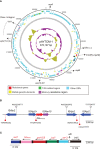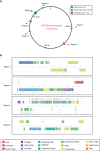Complete genetic characterization of carbapenem-resistant Acinetobacter johnsonii, co-producing NDM-1, OXA-58, and PER-1 in a patient source
- PMID: 37692162
- PMCID: PMC10486904
- DOI: 10.3389/fcimb.2023.1227063
Complete genetic characterization of carbapenem-resistant Acinetobacter johnsonii, co-producing NDM-1, OXA-58, and PER-1 in a patient source
Abstract
The emergence of carbapenemase-producing Acinetobacter spp. has been widely reported and become a global threat. However, carbapenem-resistant A. johnsonii strains are relatively rare and without comprehensive genetic structure analysis, especially for isolates collected from human specimen. Here, one A. johnsonii AYTCM strain, co-producing NDM-1, OXA-58, and PER-1 enzymes, was isolated from sputum in China in 2018. Antimicrobial susceptibility testing showed that it was resistant to meropenem, imipenem, ceftazidime, ciprofloxacin, and cefoperazone/sulbactam. Whole-genome sequencing and bioinformatic analysis revealed that it possessed 11 plasmids. bla OXA-58 and bla PER-1 genes were located in the pAYTCM-1 plasmid. Especially, a complex class 1 integron consisted of a 5' conserved segment (5' CS) and 3' CS, which was found to carry sul1, arr-3, qnrVC6, and bla PER-1 cassettes. Moreover, the bla NDM-1 gene was located in 41,087 conjugative plasmids and was quite stable even after 70 passages under antibiotics-free conditions. In addition, six prophage regions were identified. Tracking of closely related plasmids in the public database showed that pAYTCM-1 was similar to pXBB1-9, pOXA23_010062, pOXA58_010030, and pAcsw19-2 plasmids, which were collected from the strains of sewage in China. Concerning the pAYTCM-3 plasmids, results showed that strains were collected from different sources and their hosts were isolated from various countries, such as China, USA, Japan, Brazil, and Mexico, suggesting that a wide spread occurred all over the world. In conclusion, early surveillance is warranted to avoid the extensive spread of this high-risk clone in the healthcare setting.
Keywords: Acinetobacter johnsonii; NDM-1; OXA-58; PER-1; carbapenem resistance; integron.
Copyright © 2023 Tian, Song, Ren, Huang, Wang, Fu, Zhao, Bai, Fan, Ma and Ying.
Conflict of interest statement
The authors declare that the research was conducted in the absence of any commercial or financial relationships that could be construed as a potential conflict of interest.
Figures





Similar articles
-
Emergence of uncommon KL38-OCL6-ST220 carbapenem-resistant Acinetobacter pittii strain, co-producing chromosomal NDM-1 and OXA-820 carbapenemases.Front Cell Infect Microbiol. 2022 Aug 12;12:943735. doi: 10.3389/fcimb.2022.943735. eCollection 2022. Front Cell Infect Microbiol. 2022. PMID: 36034705 Free PMC article.
-
Whole-Genome Analysis of Two Copies of bla NDM-1 Gene Carrying Acinetobacter johnsonii Strain Acsw19 Isolated from Sichuan, China.Infect Drug Resist. 2020 Mar 23;13:855-865. doi: 10.2147/IDR.S236200. eCollection 2020. Infect Drug Resist. 2020. PMID: 32273730 Free PMC article.
-
Molecular epidemiology of clinical isolates of carbapenem-resistant Acinetobacter spp. from Chinese hospitals.Antimicrob Agents Chemother. 2007 Nov;51(11):4022-8. doi: 10.1128/AAC.01259-06. Epub 2007 Sep 10. Antimicrob Agents Chemother. 2007. PMID: 17846127 Free PMC article.
-
The carbapenem resistance gene blaOXA-23 is disseminated by a conjugative plasmid containing the novel transposon Tn6681 in Acinetobacter johnsonii M19.Antimicrob Resist Infect Control. 2020 Nov 9;9(1):182. doi: 10.1186/s13756-020-00832-4. Antimicrob Resist Infect Control. 2020. PMID: 33168102 Free PMC article.
-
Clinical carbapenem-resistant Klebsiella pneumoniae isolates simultaneously harboring bla NDM-1, bla OXA types and qnrS genes from the Kingdom of Bahrain: Resistance profile and genetic environment.Front Cell Infect Microbiol. 2022 Oct 11;12:1033305. doi: 10.3389/fcimb.2022.1033305. eCollection 2022. Front Cell Infect Microbiol. 2022. PMID: 36304935 Free PMC article.
Cited by
-
Identification of IncA Plasmid, Harboring blaVIM-1 Gene, in S. enterica Goldcoast ST358 and C. freundii ST62 Isolated in a Hospitalized Patient.Antibiotics (Basel). 2023 Nov 25;12(12):1659. doi: 10.3390/antibiotics12121659. Antibiotics (Basel). 2023. PMID: 38136693 Free PMC article.
-
Analysis of Acinetobacter P-type type IV secretion system-encoding plasmid diversity uncovers extensive secretion system conservation and diverse antibiotic resistance determinants.Antimicrob Agents Chemother. 2024 Dec 5;68(12):e0103824. doi: 10.1128/aac.01038-24. Epub 2024 Nov 4. Antimicrob Agents Chemother. 2024. PMID: 39494882 Free PMC article.
-
Antimicrobial resistance transmission in the environmental settings through traditional and UV-enabled advanced wastewater treatment plants: a metagenomic insight.Environ Microbiome. 2025 Mar 6;20(1):27. doi: 10.1186/s40793-024-00658-2. Environ Microbiome. 2025. PMID: 40050994 Free PMC article.
-
Characterization of the Diversity in Host Range of an Extensively Drug-Resistant (XDR) Type IV Secretion System-Encoding Plasmid in Acinetobacter.Pathogens. 2025 Jun 19;14(6):606. doi: 10.3390/pathogens14060606. Pathogens. 2025. PMID: 40559614 Free PMC article.
References
Publication types
MeSH terms
Substances
Supplementary concepts
LinkOut - more resources
Full Text Sources
Miscellaneous

